The other night I was making eggs when this happened. My stainless steel frying pan ended up with a thin layer of burnt eggs on the bottom and sides that was very difficult for me to scrape off or wash.
That thin layer of eggs sure was a pain. So I did some research and decided to test out the simplest solution to this problem of them all. Happily for me, it worked.
If you’ve found yourself in a similar situation, I’m going to help you get out of it; only with tap water and in less than 10 minutes.
How can you clean burnt eggs off a stainless steel frying pan?
You can remove burnt eggs from a stainless steel pan by filling the pan with enough water and bringing the water to a boil for 1-2 minutes. Scrape off the burnt eggs with a spatula, remove the pan from the heat, let it cool, and rinse it.
Some authors that I read recommended soaking the pan in soapy water for a couple of hours. Others wrote about making a homemade cleaning solution with white vinegar or baking soda.
Though all of them had shared good ideas with solid reasoning, I found that the simplest approach of them all—filling your frying pan with tap water and bringing it to a boil for 2-3 minutes—worked out better than I expected. So I didn’t even think of trying the rest.
Professional chefs call this technique deglazing, and they use it to cook up pan sauce on the fly. Deglazing works just as well to clean the pan as it does to make a sauce out of stuck-on food scraps.
When you deglaze a frying pan, you add cold liquid to it while it’s still hot, turning up the heat on your cooktop to high.
As a result, you’ll get a lot of steam (so make sure to turn on your kitchen vent fan to the highest setting if you have one) and the food residue in the pan will lift off from its bottom or sides, with the smallest food particles dissolving into the boiling water.
So use this technique for burnt eggs or whenever any food burns and gets stuck on the bottom and/or sides of your frying pan.
It’s so simple and so powerful, it’s almost hard to believe it works so well (and in less than 10 minutes).
Here are my step-by-step instructions (with photos):
How to Clean Burnt Eggs Off a Stainless Steel Frying Pan
Equipment
- Frying pan
- Non-scratch scrub sponge
Materials
For Deglazing the Pan
- 2 cups tap water
For Cleaning the Pan
- 1 piece non-scratch scrub sponge
- 1 squeeze dish soap
Instructions
Deglaze the Pan
- Don't try to scrape the burnt eggs off of your frying pan as you risk to scratch and damage its cooking surface.

- While your pan is still hot, add 2 cups of water (or enough to cover the bottom and sides) and turn the heat on your cooktop up to high.

- Let boil for 2-3 minutes. Use a wooden or silicone spatula, pressing down to scrape off the thin layer of burnt eggs that was stick to the cooking surface.
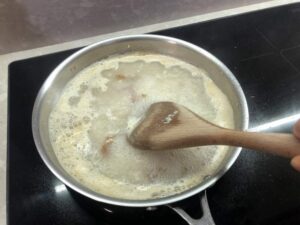
Clean the Pan by Hand in Soapy Water
- Drain the water from the pan in the kitchen sink. To prevent egg residue from falling into the sink, put on the drain strainer or pour the water into a colander.
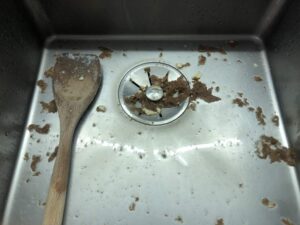
- At this stage, only a little burnt egg residue should be left on the bottom and/or sides of your frying pan. This residue is easy to clean off by hand.
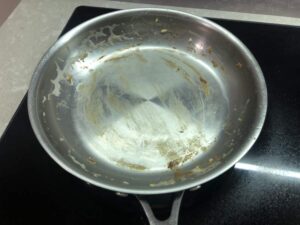
- Using dish soap and a scrub sponge, cover the pan in soapy water and let sit for 2-3 minutes. Then scrub the pan clean. Some areas may need more persistent scrubbing than others.
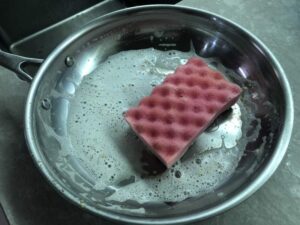
- You're done! Thanks to the magic of deglazing, your stainless steel frying pan should now look as good as new.
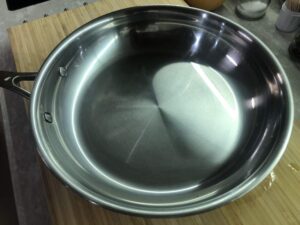
If you are like me, you’re not going to stop there, though.
As soon as I managed to clean the burnt eggs off of my stainless steel frying pan, I started asking myself…
Why do eggs get stuck to your frying pan in the first place? And is there anything that I can do the next time I make eggs to prevent that from happening?
Why Eggs Get Stuck to Your Stainless Steel Frying Pan
When you cook eggs in a stainless steel frying pan, the proteins in the egg will form chemical bonds with the surface of the pan. Whereas the non-stick coating on non-stick and ceramic pans interferes with that reaction, stainless steel frying pans have a cooking surface of bare steel.
Steel also expands and contracts as it heats up and cools down. Though your stainless steel pan looks smooth and shiny to the naked eye, it’s actually covered with microscopic imperfections that get bigger and smaller as you use the pan and change the heat on your cooktop.
Adding cold ingredients to a hot frying pan will cause it to lose temperature, which will then cause these microscopic dents and scratches to contract—catching onto the food that you’re cooking and causing it to get stuck.
How to prevent this?
To keep eggs from sticking to your stainless steel frying pan, coat the cooking surface of the pan with enough butter or oil and allow it to preheat (2-3 minutes on most cooktops) for enough time.
After you pour the eggs into the pan, let them cook and solidify for a while before stirring them with a spatula. The better the proteins in the eggs have cooked, the less they’ll get stuck to the bottom and sides of your pan after you stir them.
Of course, the extent to which you’re willing to cook your eggs depends on what recipe you’re making and how you like them.
The Bottom Line
Cleaning burnt eggs of your stainless steel pan is easier than it seems. Just use the technique that professional chefs call deglazing to get the burnt eggs unstuck from the pan. Then clean your pan by hand with soapy water and a scrub sponge.
To keep eggs from sticking to your pan in the first place, make sure to coat it with butter or cooking oil and preheat it for 2-3 minutes before you add the eggs in.
Tried this technique? Let me and the rest of this post’s readers know how it turned out for you by leaving a comment below.
